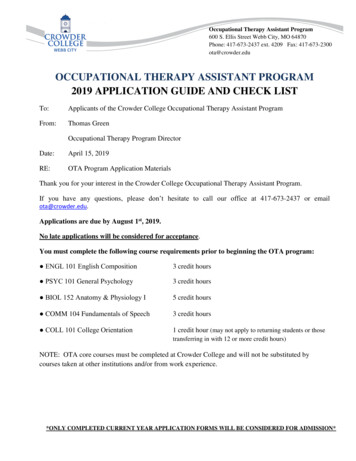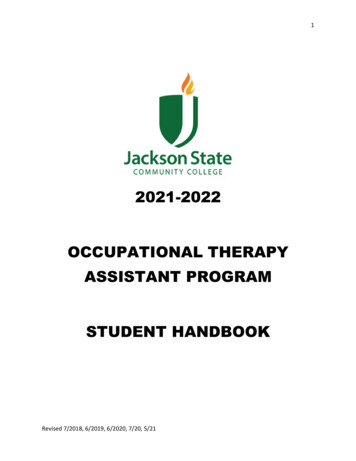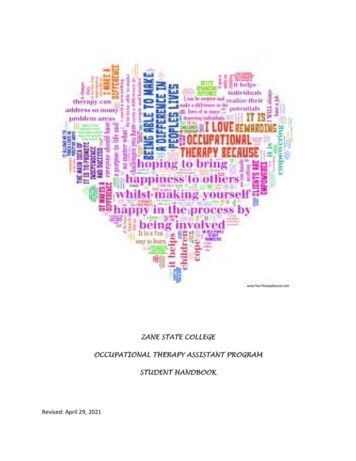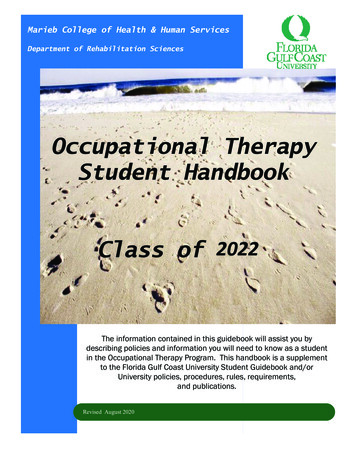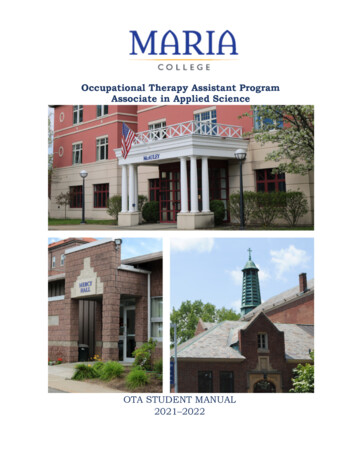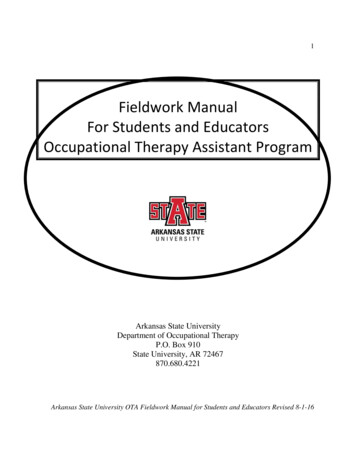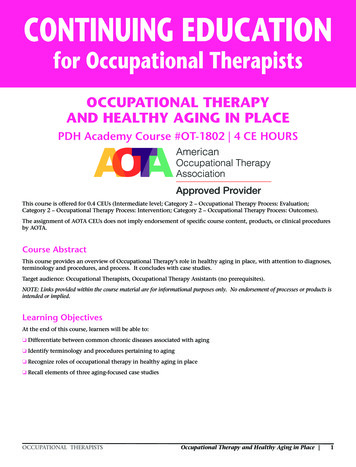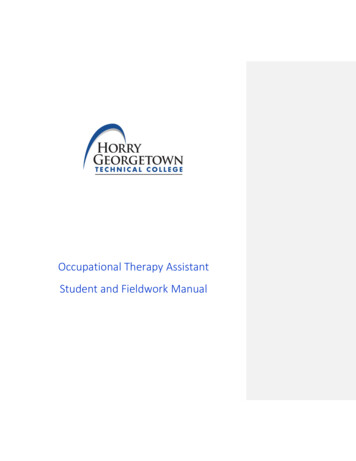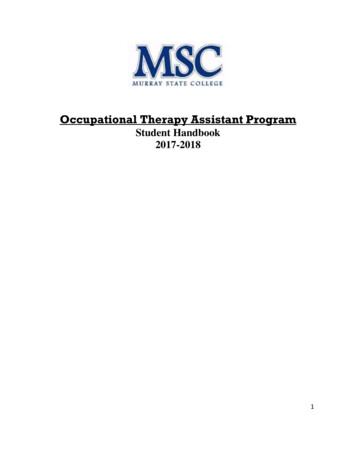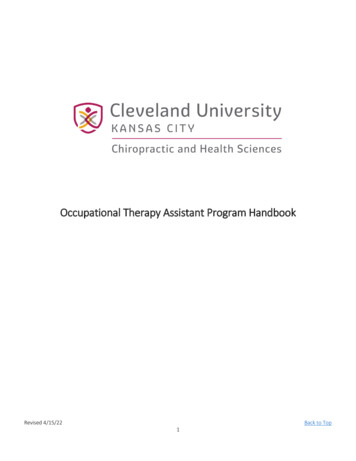
Transcription
Occupational Therapy Assistant Program HandbookRevised 4/15/22Back to Top1
Table of ContentsTable of Contents . 2Prelude . 4Introduction . 5Program Faculty and Contact Information . 5Accreditation . 6Program Responsibilities . 6THE CUKC INSTITUTIONAL VISION . 7THE CUKC INSTITUTIONAL MISSION . 7CORE VALUES . 7MISSION OF THE COLLEGE OF HEALTH SCIENCES . 7Cleveland University-Kansas City Occupational Therapy Assistant Program . 8OTA Program Mission Statement . 8OTA Program Vision Statement . 8Philosophy . 8Curriculum . 9Credit/Contact Hour Distribution . 9Transfer Students- A.A.S. in Occupational Therapy Assistant . 10Student Learning Outcomes . 11Graduation Requirements - A.A.S. in Occupational Therapy Assistant . 11Academic Policies and Procedures . 12Nondiscrimination Policy . 12Tuition and Fees . 12Academic Calendar . 12Professional Behavior Standards . 12Dress Code and Professional Appearance Standards . 12Information Exchange and Communication . 13Technical Standards . 13Classroom Guidelines . 14Program Standard Procedures . 16Inclement Weather Policy . 16Background Check Policy . 17Drug Screening Policy . 17Health Status . 18Immunization Policy. 18CPR Certification . 18Health Insurance . 18Revised 4/15/22Back to Top2
Academic Expectations and Standing. 19Grading Scale . 19Student Advisement . 19Program Dismissal . 19Course/Program Withdrawal . 20Complaints and Informal Resolution . 20Grievances and Appeals Policy . 20Fieldwork Experiences Overview. 21Level I Fieldwork . 21Level II Fieldwork . 22Fieldwork policies and procedures can be located in the OTA Program Fieldwork Manual. . 23Revised 4/15/22Back to Top3
PreludeCleveland University-Kansas City’s (CUKC) Occupational Therapy Assistant (OTA) program reserves the right, without prior notice, tomake changes at any time to the material contained in this program handbook, including but not limited to, entrance and graduationrequirements, curriculum, academic policies, and any rules and regulations.Occupational Therapy Assistant students are required to familiarize themselves with and abide by the rules and regulations of theOccupational Therapy Assistant programs’ publications in this handbook.The OTA program has policies and procedures unique to the OTA program. Should a policy or procedure in this Handbook differ fromother University publications, it is to be understood that this Occupational Therapy Assistant Student Handbook takes precedenceover any and all other University publications.The provisions of this handbook shall in no way be construed as a contract between Cleveland University-Kansas City and any student.Revised 4/15/22Back to Top4
IntroductionWelcome to Cleveland University-Kansas City and congratulations on being accepted to the Associate of Applied Science (A.A.S.) –Occupational Therapy Assistant Program! This handbook provides details about the program, which may be helpful to reference.Program Faculty and Contact InformationRachel Eisfelder, MOT, OTR/LProgram Rachel received her Bachelor of Science degree in Psychology from Culver-Stockton College and her Master of Occupational Therapydegree from St. Ambrose University. She is a registered occupational therapist with the National Board for Certification inOccupational Therapy (NBCOT). Rachel’s clinical experience has been primarily in mental health and for the last eight years, she hasworked in OTA education. Rachel is an active member of the American Occupational Therapy Association (AOTA) and the stateoccupational therapy association.Jeanne Boone, B.A., COTA/LAcademic Fieldwork s. Boone earned a B.A. in political science from Rockhurst University, and an A.A.S. in Occupational Therapy Assistant fromMetropolitan Community College-Penn Valley. She has more than 20 years of experience as a Certified Occupational TherapyAssistant (COTA), and has worked in acute care, geriatric, pediatric, and rehabilitation settin gs. While working, shesupervised fieldwork students, which peaked her interest in OTA education. She has seven years’ experience in OTAeducation: first as an instructor primarily in geriatric and rehabilitation practice courses, and six years’ experience serving asstaff as an academic fieldwork coordinator. When not working, she enjoys spending time with family and friends, her dog,and watching football, baseball, soccer and some college basketball.Revised 4/15/22Back to Top5
AccreditationThe Occupational Therapy Program (OTA) at Cleveland University-Kansas City is accredited by the Accreditation Council forOccupational Therapy Education (ACOTE) of the American Occupational Therapy Association (AOTA), located at 6116 ExecutiveBoulevard, Suite 200, North Bethesda, MD 20852-4929. The phone number for ACOTE is (301) 652-AOTA (2682), and the Webaddress is www.acoteonline.org.Graduates are eligible to sit for the national certification examination for the occupational therapy assistant administered by theNational Board for Certification in Occupational Therapy (NBCOT). After successful completion of this exam, the individual will be aCertified Occupational Therapy Assistant (COTA).In addition to initial certification, state licensure is require to practice; however, state licenses are usually based on the results of theNBCOT Certification Examination. Note that a felony conviction may affect a graduate’s ability to sit for the NBCOT certificationexamination or attain state licensure.Program ResponsibilitiesThe Program Director assumes primary responsibility for communication with ACOTE and will: Inform ACOTE of the transfer of program sponsorship or change of the institution’s name within 30 days of the transfer orchange. Inform ACOTE within 30 days of the date of notification of any adverse accreditation action taken to change the sponsoringinstitution’s accreditation status to probation or withdrawal of accreditation. Notify and receive ACOTE approval for any significant program changes prior to the admission of students into thenew/changed program. Inform ACOTE within 30 days of the resignation of the program director or appointment of a new or interim program director. Pay accreditation fees within 90 days of the invoice date. Submit a Report of Self-Study and other required reports (e.g., Interim Report, Plan of Correction, Progress Report) within theperiod of time designated by ACOTE. All reports must be complete and contain all requested information. Agree to a site visit date before the end of the period for which accreditation was previously awarded. Demonstrate honesty and integrity in all interactions with ACOTE.Revised 4/15/22Back to Top6
THE CUKC INSTITUTIONAL VISIONThe University’s vision is to be recognized and respected as a leader in health promotion.THE CUKC INSTITUTIONAL MISSIONThe University’s mission is to provide strong student-centered academic and professional education with a focus in theareas of life sciences and health promotion through education, scholarship and service.CORE VALUESIntegrity/Accountability Responsible and ethical behavior Honest and open communication Responsibility for our individual actions Excellence/Service Highest quality in teaching, scholarship and service Embrace compassionDiversity/Respect Treat all individuals with dignity and respect Encourage an environment that attracts, nurtures and supports diversity Sensitivity to differences in learning styles, ideas and beliefsCollaboration/Teamwork Partnerships, interaction and relationships Cooperative efforts to achieve our common goalsHealth/Well-being Encourage activities and behaviors that contribute to a healthy lifestyle Chiropractic care is essential for optimizing health and well-beingInnovation/Creativity Intellectual curiosity Enthusiastic pursuit of new ideasMISSION OF THE COLLEGE OF HEALTH SCIENCESTo provide respected and recognized undergraduate and graduate programs specializing in life sciences and healthpromotion preparing graduates to continue in health-related education programs.Revised 4/15/22Back to Top7
Cleveland University-Kansas City Occupational Therapy Assistant ProgramOTA Program Mission StatementOur mission is to provide exceptional quality academic and clinical education to develop compassionate and resourcefulpractitioners who integrate skills centered on the whole person to facilitate participation in everyday living.OTA Program Vision StatementTo develop innovative, compassionate leaders as occupational therapy practitioners.PhilosophyPeople are dynamic, complex and ever changing. As occupational therapy practitioners, we assess and analyze peoplebased on their physical, social and contextual characteristics. We explore how each person interacts with theirenvironment and how well they are able to perform the occupations that are meaningful and purposeful to their dailylives. Knowing how each of these components (person, environment, and occupation) interact with each other for anindividual allows the occupational therapy practitioner to assess one’s satisfaction with occupational performance.The OTA program utilizes a developmental philosophy in the approach to teaching about the person. Coursework is set upto address occupations across the lifespan, starting from children and moving through older adults. Additionally, theprogram philosophy utilizes development with learning when approaching the education of students through theoccupational therapy process. The Person-Environment-Occupation-Performance (PEOP) Model and the Model of HumanOccupation (MOHO) provide frameworks for the student to begin the process of analyzing the components of anindividual, group, or population and the interactions of each component to explore and create intervention for those theyserve.Each practice model, while having their own nuances, allows students to explore occupational performance in parts andas a whole. By using these models, students are able to utilize these ideas throughout the program. It allows for contextwhen learning and applying the Occupational Therapy Practice Framework (OTPF), creating occupational profiles, anddeveloping intervention. The OTA faculty believe in educating students to become innovative, forward-thinking, flexiblepractitioners who are ready to help meet society’s healthcare needs. We believe that occupational performance is themain concern when approaching treatment interventions across the lifespan. The ideas presented in the adult learningtheories, experiential learning theories, and through self-reflection, allow students to utilize their own experiences andcontexts, utilize a hands-on approach to demonstrate competencies, and reflect on their learning process and how skillshave improved.The curriculum has three organizing threads that structure courses and learning experiences: Occupation is the central focus of the profession and a major determinant of health, wellness, and quality of life. Evidence-based practice guides sound clinical reasoning, advances the profession, and encourages lifelonglearning. Professional behavior and development strengthen one’s identity within the profession and allows for skillbuilding within occupational therapy.These threads are found throughout the course curriculum. At the beginning of the program a foundation is laidintroducing all three threads and what each means to the profession. Through practice, application, and self-reflection,students are able to implement each of these threads into their practice as occupational therapy assistants. Students areassessed in coursework with Observed Structural Clinical Examinations (OSCE) in order to assess their use of occupationbased interventions as well as their application of evidence-based practice. Professional behavior is assessed in the OSCEas well as at the end of each trimester during a scheduled supervision meeting with OTA faculty.Revised 4/15/22Back to Top8
CurriculumAll general education course work must be completed prior to enrollment in the OTA coursework. BIOL 250, BIOL 251 and HSCI 102need a grade of a “B” or better. All other course work must be completed with a “C” or better. The OTA professional courses mustbe completed in sequence and within 24 months of starting the professional phase of the OTA program (150% of the program’slength). Students must complete all OTA professional courses with a grade of C or better.Credit/Contact Hour DistributionTerm 1Module 1Module 2Term 2Module 1Module 2Term 3Module 1Module 2Term 4Module 1Module 2Term 5Module 1Module 2Term 6Module 1Module 2Course IDCourse TitleTotalcredithoursBIOL 250ENGL 101BIOL 251MATH 115Anatomy & Physiology IEnglish Composition IAnatomy & Physiology IIMath for Natural Sciences434314SPCH 101HISC 102PSYC 110COMM 201SpeechHealth Science TerminologyGeneral PsychologyCommunication and Diversity313310OTHA 110OTHA 115OTHA 120OTHA 130Principles of OTHuman Movement for OTAnalysis of PerformanceOccupations Across the Lifespan244212OTHA 150OTHA 160OTHA 170OTHA 180Children and YouthLevel I FW - IRehabilitation and DisabilityLevel I FW - II424212OTHA 210OTHA 220OTHA 230OTHA 240Mental HealthLevel I FW - IIIPracticumHealthcare Management in OT423312OTHA 250OTHA 260OTHA 280Level II FW - ILevel II FW - IIOT Seminar6611373Revised 4/15/22Back to Top9
Transfer Students- A.A.S. in Occupational Therapy AssistantCleveland University-Kansas City’s Occupational Therapy Assistant program does not accept transfer credit of core OccupationalTherapy Assistant courses from any institution. General education courses may be accepted for transfer in compliance with “Studentswith Advanced Standing/Transfer Credits” policy in the University Catalog.Revised 4/15/22Back to Top10
Student Learning OutcomesThe Occupational Therapy Assistant Program’s goals are consistent with the accreditation standards. By the end of theprogram, the student will show competence in the following:1. FOUNDATIONAL CONTENTUtilize foundational content in order to develop and create client-centered interventions.2. OT THEORYAnalyze relevant OT theoretical perspective in determining and developing intervention and shaping OT practice3. BASIC TENETSImplement the domains and processes of occupational therapy in order to understand the basic tenets of theprofession.4. OT PROCESSAnalyze their role in the OT process, in collaboration with the OT and based on available evidence5. CONTEXT OF SERVICE DELIVERY, LEADERSHIP, AND MANAGEMENT OF OCCUPATIONAL THERAPY SERVICESDemonstrate an understanding of the context of service delivery, leadership, and management of OT services6. SCHOLARSHIPDifferentiate and interpret the use of scholarly articles in evidence-based practice.7. PROFESSIONAL ETHICS, VALUES, AND RESPONSIBILITIESApply and justify professional ethics, values and responsibility within OT practice.Graduation Requirements - A.A.S. in Occupational Therapy AssistantIn order to graduate in good standing, the student must: Complete the program of study, including both required Level II fieldwork, within 24 months of starting the OTAcore coursework. Complete all OTA courses with a grade of C or higher. Complete both Level II fieldwork with at least 70 points or higher on the AOTA fieldwork performance evaluation(FWPE) with no score of 2 at final for the Fundamentals of Practice section of the FWPE. Recommendation for graduation by the A.A.S. in Occupational Therapy Assistant faculty. Resolve all outstanding financial obligations to Cleveland University-Kansas City. Complete exit interview.NOTE: “Students must complete Level II fieldwork within 8 months following completion of the didactic portion of theprogram.”Revised 4/15/22Back to Top11
Academic Policies and ProceduresNondiscrimination PolicyCleveland University-Kansas City and the Occupational Therapy Assistant program are committed to equal opportunity andnondiscrimination in all programs and services, and do not discriminate on the basis of race, color, religion, sex, national origin,ancestry, age, sexual orientation, marital status, disability, or veteran status.Tuition and FeesCleveland University-Kansas City provides up-to-date information about tuition and fees. The University Catalog clearly indicates that“The University reserves the right to alter tuition or fees and the regulations governing as deemed necessary and without notice.”Academic CalendarThe OTA program follows the academic calendar of Cleveland University-Kansas City.Professional Behavior StandardsThe OTA program holds professional behavior in high regard. In order to prepare students for practice, the program will utilize aprofessional behavior self-assessment. Students will take this self-assessment multiple times throughout their program and will meetwith OTA faculty to discuss their progress with professional behaviors. The following behaviors will be addressed in the selfassessment: Dependability Organization Professional presentation Clinical reasoning Initiative Supervisory process Empathy Verbal communication CooperationWritten communicationStudents are expected to exhibit professional behavior at all times. Behaviors not aligned with the OTA program include the followingbut are not limited to: Any form of academic misconduct including cheating, and/or dishonesty Breaching confidentiality Exhibiting behaviors that could be regarded as harassment Plagiarism Misrepresentation of any work submitted for evaluationViolation of professional behavior standards may result in disciplinary action at the discretion of the OTA faculty and OTA ProgramDirector.Dress Code and Professional Appearance StandardsThe Occupational Therapy Assistant program is a professional program and students are expected to present themselves in a neat,clean, and professional manner at all times. The OTA program maintains a firm dress code with regard to classroom/lab andfieldwork/clinical situations including fieldtrips, observations, presentations, and Level I and Level II fieldwork. Professionalappearance required in the above identified settings should be observed: conventional hair color/style and conservative use of jewelryand make-up.The following are general guidelines for professional dress and appearance:Revised 4/15/22Back to Top12
Student ID badgeStudents will receive an ID badge from the University. Student ID badges should be worn at all times in plain view at chestlevel at chest level while in the community representing CUKC.FootwearClosed toe, closed heel shoes with nonskid soles, no heelsClothing should be business casual attire, khaki pants, black, gray, or navy blue scrub bottoms with the OTA program issued polo shirt.No athletic wear, shorts, leggings, or jeansNo t-shirts, low-cut shirts/blouses, or tank tops/spaghetti strapsNo revealing clothing or visible undergarmentsNo scarves or other flowing clothingJewelry/Body artNo more than two studded earrings per ear, no dangling/hoop earringsNo exposed tattoos or facial/body piercingsOtherNatural occurring hair colorLong hair tied/pulled back away from faceFacial hair neat/trimmedNo artificial or acrylic nails, nails cleaned cut to appropriate length, no nail polishConservative makeupStudents are representatives of CUKC and the OTA program, the fieldwork site, and the occupational therapy profession, as well asthemselves to patient/clients, family members, other professionals, and potential employers. Thus, students will be responsible foradhering to the professional appearance standards and dress code set by the Program and FW sites.Fieldwork specific dress code information can be located in the OTA Program Fieldwork Manual. Failure to comply with the dress codemay result in being sent home from class/lab, or fieldwork. Time missed will contribute to the Attendance Policy and will result indisciplinary action at the discretion of the AFWC and/or the Program Director.Information Exchange and CommunicationThe student’s assigned CUKC email address will be the primary mode of formal communication between the University and/orProgram and the student. Students are required to read and respond to emails within 72 hours of receipt. The student is considerednotified when the University or Program official has received receipt of delivery to the student’s CUKC email.Technical StandardsAll students are required to meet and maintain Technical Standards of the OTA program. Students must demonstrate the ability todeliver occupational therapy services in a safe and effective manner under the supervision of the OccupationalTherapist/Occupational Therapy Assistant. All students must meet the technical standards for admission or participation in the OTAprogram with or without reasonable accommodation. The technical standards outlined below are necessary skills and behaviors forsuccessful completion of this program. It is the student’s responsibility to disclose any limitations that might interfere with his/hermeeting these standards.Cognitive FunctionsRevised 4/15/22Back to Top13
Ability to effectively attend to multiple tasks, personal, and/or group interaction to include ability to selectively focus, utilizingdivided and alternating attention in a quick, safe manner. Ability to organize concepts, schedule, materials, and work space.Ability to engage in decision-making and problem-solving for use in clinical reasoning and safe practice.Written and Verbal Communication Ability to use English in both written and spoken language for effective communication with individuals in all health careprofessions, patients/clients, family members and care providers.Strength Adequate body strength and endurance to sustain work level on a full-time basis, while performing intermittent moderate toheavy work levels (lifting of 10 lbs. above shoulder level; lifting, pushing, pulling 50 lbs., handling therapy equipment). Ability to assist a person to move to different positions and surfaces.Coordination Ability to use fine skilled movements, such as finger dexterity and eye-hand coordination, for effective use of tools, splintfabrication, dressing, personal hygiene, grooming, cooking and written communication skills.Sensory Visual acuity (with correction, as needed) for close observation of one or more persons at a 10-foot distance, and closelymonitor facial expressions, skin coloration, muscular tension, and detailed workmanship. Auditory acuity (with correction, as needed) to comprehend one or more persons engaged in conversation, and to hearmonitoring, communication and safety devices, and signals. Spatial reasoning abilities sufficient to plan and implement modifications of tools, materials and the environment, and toobserve human movement. Tactile ability to feel vibrations, detect temperature, feel differences in surface characteristics, feel differences in sizes andshapes, and detect environmental temperature. Ability to detect odors from patient, smoke, gases or noxious smells.Professional Behaviors and Work Ethic Capacity to use effective work ethic skills to include attendance, punctuality, positive work attitude, respect, cooperat
The Occupational Therapy Program (OTA) at Cleveland University-Kansas City is accredited by the Accreditation Council for Occupational Therapy Education (ACOTE) of the American Occupational Therapy Association (AOTA), located at 6116 Executive Boulevard, Suite 200, North Bethesda, MD 20852-4929.
